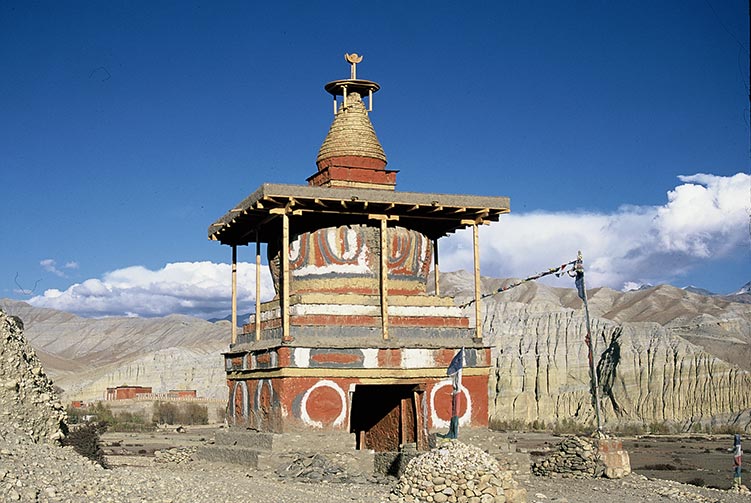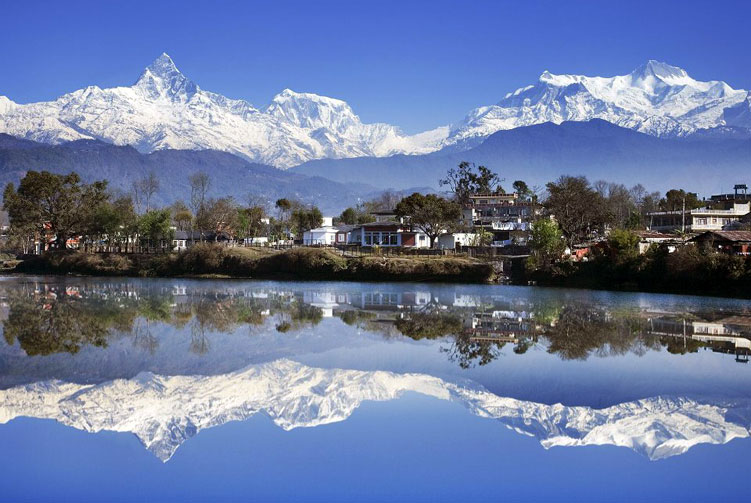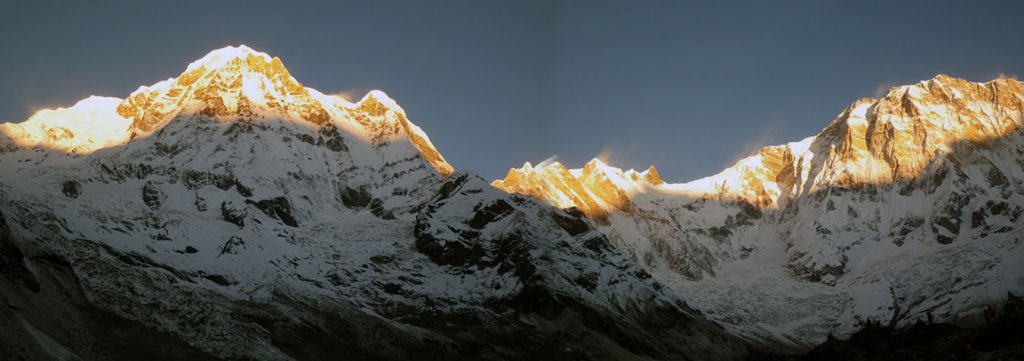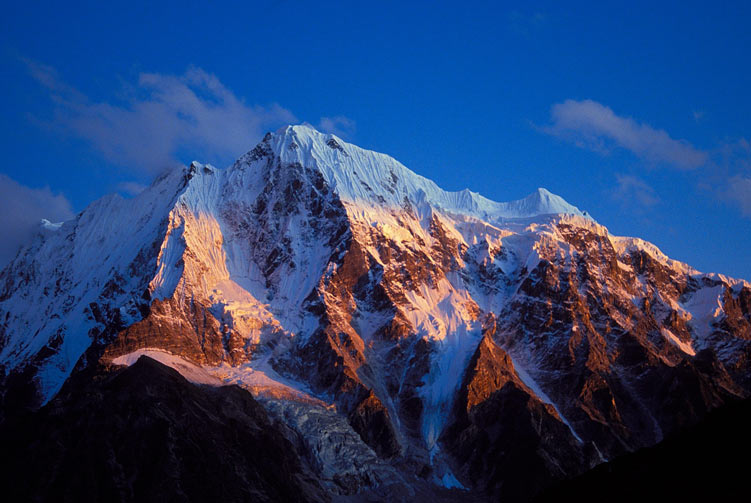Ganja La Peak Climbing, also known as Naya Kanga Peak Climbing, is a beautiful and popular peak climbing adventure in Langtang region of the Himalaya. This adventure aims to summit a beautiful and 5,844 meters high Himalayan peak that boasts breathtaking views of the surrounding Himalayas.
Overview
A wonderful and coveted peak in the Langtang region, Naya Kanga Peak is reached after exploring some awesome attractions in the Langtang valley. The culture, natural serenity and fascinating views along the trekking route towards the peak already make this trip beautiful. The summit adventure of the peak adds to the charm of trekking adventure that you take before the actual climbing adventure begins.
Although the peak is lower than 6,000 meters, climbing this peak can be as adventurous as any other climbing peaks in Nepal. This truly gets you alpine climbing experience once you start climbing from the high camp. After crossing the short snowy ridge on the north-east side, you reach the summit of the peak to have spectacular views of mountains in Nepal and Tibet. Some of the mountains that the top brings to your view are Langtang Lirung, Shishapangma, Langshisha Ri, Pemthang Ri, Langtang II and many other peaks.
Trip Highlights
- Cultural Sightseeing tour of Kathmandu
- The journey to Ganjala Peak involves trekking through beautiful landscapes, rhododendron forests, and traditional villages.
- You'll be surrounded by stunning Himalayan landscapes, with breathtaking views of nearby peaks and glaciers.
- Hiking up to Tserko Ri 5,000m
- Ganjala Peak stands at over 17,000 feet (5,100 meters), providing an exhilarating high-altitude experience.
Itinerary
Today is the day of your arrival in Kathmandu, Nepal. As soon as you come out of the Kathmandu airport, you will find our representative waiting for you in the waiting area right outside the arrival lounge. You will be warmly greeted and welcomed by the representative and led to the vehicle. Our vehicle will take you to the trip hotel, most of the time in Thamel, that is 20-30 minutes drive, depending upon traffic, from the airport.
Enjoy your breakfast at the hotel. We come to take your for a wonderful cultural heritage tour of Kathmandu valley. As part of the tour, we are going to visit four of the UNESCO Heritage monuments in Kathmandu valley. The places we visit today are incredible mixture of culture, history, spirituality, art and stories. Overnight in Hotel.
Swoyambhunath
Believed to have been created on its own, this Budhhist stupa is the oldest of all the monuments in Kathmandu valley. Standing atop a small hillock, Swoyambunath, known as monkey temple amongst tourists, provides a fascinating view of the valley, surrounding hills and snow-capped mountain at the distance on a clear day.
Patan Durbar Square
One of the three medieval palace squares, Patan Durbar Square holds its medieval art and architectural grandeur. Amazing skill of the artisans is evident in each and every building that stands in the square. The square comprises of medieval palace, temples and museum.
Pashupatinath
This site is the most sacred Hindu temple area in the country. But, as the temple is strictly a Hindu only area, non-Hindu tourists go there to watch the unique Hindu cremation rituals on the bank of River Bagmati. The death rites of Hindu family there are so engrossing and heart-touching which make you feel the moment. It’s not any kind of intrusion in being there and watching somebody being cremated in an open ground. It’s a great cultural experience.
Boudhanath
This giant Buddhist stupa is considered as the biggest one in the world. This small square with giant shrine has a powerful presence of the spiritual vibrations. It’s an important pilgrimage site for the people following Tibetan Buddhism.
We get ready for a day long drive to Syabrubesi, the trek starting point, after early breakfast. The road journey heads towards the destination through a narrow highway that goes outside Kathmandu and winds through beautiful green hills. Most of the stretch of the drive today goes through beautiful mountain sceneries and also passes through several towns and villages along the way. Eventually, we reach Syabrubesi after about seven hours of drive and laze around this small and charming town.
We get ready for a day long drive to Syabrubesi, the trek starting point, after early breakfast. The road journey heads towards the destination through a narrow highway that goes outside Kathmandu and winds through beautiful green hills. Most of the stretch of the drive today goes through beautiful mountain sceneries and also passes through several towns and villages along the way. Eventually, we reach Syabrubesi after about seven hours of drive and laze around this small and charming town.
We are going to enter the Langtang valley today. The first part of the day takes us through a gentle uphill and it becomes steeper as we go higher. We walk through forested area and cultural villages. We enter the Langtang National Park after checking in to the area at Ghoda Tabela check post. As we walk slowly ahead on our pace, we can see the Langtang valley getting wider as we approach there.
Langtang village was swept away by the destructive earthquake in 2015 so we do not see the village in the place where it used to be before that devastation. Now, guest houses are built a little further ahead in the place called Mundu. We reach Mundu and laze around for the rest of the day.
We trek to Kyanjing Gompa today. Our walk takes us higher in the elevation and deeper into the Langtang Valley. We can feel influence of the Buddhist culture in the region as we trek along the trail. We pass along chhortens, mani walls, prayer flags; all of them representing the Buddhist cultural traditions. When we reach Kyanjing, we will be welcomed by spectacular view of mountain peaks. We go around the village to explore the awesomeness of the place.
We spend an additional day here in Kyanjing Gompa but we won’t necessarily stay idle. We go for an amazing hike to Tserko Ri that stands at 5,000 meters above sea level. Our day starts before the break of dawn to meet the sunrise view from the top. Stunning views of the mountain peaks along with a spectacular sunrise over the Himalayas make our day wonderful. Later, we trek back to Kyanjing village and spend the whole day exploring the spiritual beauty of monastery there and the view.
After exploring Kyanjing Gompa and village and hiking to Tserko Ri for a whole day yesterday, we start our trek towards Ganja La Base Camp today. We set off for the trek after breakfast and cross Langtang River and start uphill trek through rhododendron forest towards Ganja La Base Camp to stay overnight. Once we reach there, we explore around and try to adjust with the thinning layer of oxygen in the air.
We are trekking to the high camp today. We set off on a gentle paced walk towards the destination for the day. We are taking it as an easy day walk to the high camp. When we reach the high camp, we take our leisurely time to explore and acclimatize with the high altitude climate. The beauty of wonderful mountains keeps us engaged.
After the summit adventure, it’s time to trek back and we are heading to Kyanjing Gompa today. The trek back down to Kyanjing Gompa is feels easier as compared to the adventure effort up the peak summit. We reach Kyanjing Gompa on a relaxing pace and laze around once we are there.
We are returning back to Lama Hotel on our trek today. After spending wonderful time at Kyanjing Gompa and hiking to Tserko Ri, we are now ready to descend back to Lama hotel and then trek towards Gosainkunda. We stop overnight at Lama Hotel today to take the route to Gosainkunda tomorrow.
After a few days of quality time in the Lagntang valley, Kyanjing and Naya Kanga Peak, we are trekking back down towards Syabru village today. The trek takes us to a different route than we took to go towards Langtang valley and towards Naya Kanga Peak a few days earlier. We are going to experience a unique cultural life style of people living in the region and a wonderful natural setting of the amazing landscapes.
It’s the last day of trekking portion in the trip. We are trekking all the way back to Dhunche for overnight stay. It’s a huge drop on the elevation, almost 2,700 meters. It’s a long day of descending, descending in elevation, with the trail involving ascent and descent. Several days of exploration of the Langtang valley and Gosainkunda area comes to end today when we reach Dhunche, the district headquarters of Rasuwa.
We get ready for early morning start to drive back to Kathmandu. The same road that we took earlier to go to Syabrubesi to start the trek takes us back to Kathmandu. Once we are in Kathmandu, we go to hotel and spend the whole day at leisure on our own. Finding relieving massage, good food, souvenir shopping, and wandering around can keep you busy for the day.
A farewell dinner is scheduled for this evening. We will let you know the departure time for dinner once we reach Kathmandu.
The final day of the trip, we drive you to airport for your scheduled flight homebound or other destination. We will pick you up 3 hours prior to your flight schedule.
The Trip Cost Includes
- Airport Pick and Drop for both International and Domestic flight by Private vehicle.
- Welcome, Farewell dinner with cultural program.
- 3 Night Tourist Standard Accmmodation in Kathmandu with B/B basis.
- Half day guided city tour with world heritage entrance permit as listed in itinerary.
- Transportation from Kathmandu-Syabrubensi-Kathmandu by Local Bus.
- Standard Lodge/Guest House accommodation (best available) with twin sharing basis during the trek.
- Accommodation in Tented Camp while on Naya Kanga/Ganjala chuli Peak Climbing.
- Full Board Meals (3 Meals a day) while on the trek.
- Naya Kanga/Ganjala chuli Peak Climbing permits, TIMS Card fees, and Langtang Conservation Area entrance fees.
- All necessary camping equipments; Tent, Table & Chair for climbing expedition's crew's.
- Professional & highly expertise government licensed holder local Trekking/Climbing Guide.
- 2:1 Ratio porter carrying 30KG.
- All expenses of the staffs (Guides/Porters) that includes Food, Accommodation, Salary, Insurance, Equipment during your travel period.
- All the necessary trekking gear for porters like jacket /trousers, trekking shoes, gloves, shocks, sunglasses etc.
- Friends Adventure Team's Sleeping Bag, Walking Poles and Duffel Bag, to be return after trip completed.
- Comprehensive First Aid Kit.
- Arrangement of all rescue and evacuation promptly, in Worst Condition
- Naya Kanga/Ganjala chuli Peak Climbing group climbing gear, climbing rope, snow bars & carabineers etc.
- Trekking Map, Friends Adventure Team's special Souvenir.
- Agency service charge.
The Trip Cost Excludes
- Meals in Kathmandu and Pokhara
- Any packed food/snacks, aerated drinks, energy drinks, mineral water, alcohol, cigarettes, chocolates, nutria-bars.
- All desserts, sweet things like chocolate, cake, pie, pudding.
- Items of personal nature, Laundry Expenses, Tips.
- Clothing, Packing Items or Bags, Personal Medical Kit, Personal Trekking Gears.
- Any additional staff other than specified.
- Medical and Travel Insurance and Emergency rescue by any means of Transportation including Helicopter evacuation if required.
- Rescue, Repatriation, Medicines, Medical Tests and Hospitalization expenses.
- Airfare of international flights.
- Nepal entry visa fee (Visa issuance is easy at the arrival).
- Hot shower and battery charging on the tea houses.
- Any other item not included in "Cost Includes" Section.
Frequently asked Questions
Naya Kanga (Ganja La Chuli) Peak Climbing involves reaching the summit of Naya Kanga (Ganja La Chuli) Peak, a popular mountain in the Langtang Region of Nepal.
No, it’s not recommended for beginners. You should have prior trekking and some basic climbing experience.
The best times are spring (April to May) and autumn (September to November) when the weather is most favorable.
Yes, you should get training in essential climbing skills like using ropes and ice axes.
You can rent some equipment locally, but it’s best to bring your personal gear, especially items like well-fitting boots and clothing.
While there are no strict age limits, climbers are generally expected to be in good physical condition. It’s more about fitness than age.
Altitude sickness can occur at high altitudes and can be dangerous. Proper acclimatization, staying hydrated, and following your guide’s advice can help prevent it.
You’ll stay in tea houses or lodges during the trekking portion and eat locally available food. At higher altitudes, the options may be limited.
Yes, travel insurance that covers emergency evacuation and medical expenses is essential. Check that it also covers high-altitude activities.
Prioritize cardiovascular fitness, strength training, and endurance exercises. Hiking and trekking in your local area can also help prepare you for the altitude.
The cost can vary depending on the tour operator, the services included, and the duration of the expedition. On average, it can range from a few thousand to several thousand dollars.
Yes, many travelers choose to explore other parts of Nepal, like Kathmandu, Pokhara, or go on other trekking adventures after their peak climbing expedition.
Respect local customs, avoid littering, and use designated trails. Hiring local guides and porters also supports the local economy.
On average, you walk about 4 to 6 hours per day. One or two days can be as less as 3hrs and one or two days can be as long as 7hrs.
Yes, you can charge batteries en route. Charger should be brought. There are hot shower facilities as well. You may have to pay certain amount for both ($1-$2). Negotiate. Also, hot water facility could be free at lower elevation.
No. There are no ATMs on this trek route. You will have to draw enough cash in Kathmandu. There are a number of ATMs in these cities. Everything is paid in Nepali rupees. So money should be exchanged before the start of the trek.
Yes. Internet can be accessed in most places. Sometimes, there might be some technical problems. Internet in Nepal is not as fast as you are used to and at times you can just lose connection.
No, it’s not strictly necessary to hire a guide or trekking agency for Naya Kanga (Ganja La Chuli) Peak Climbing, but it’s highly advisable, especially if you’re not an experienced mountaineer. Guides and agencies provide essential safety, local knowledge, and logistical support. They help with permits, navigation, and emergency situations, making your climb safer and more enjoyable. While it adds to the cost, the benefits of having a guide or agency often outweigh the expense, particularly for your safety and overall experience.
For Langtang region, pay for guides range from $20 to $30 per day and porters take $15 to $25 per day.















